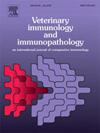针对RSPO2的骆驼源纳米体的筛选、表达和功能验证
IF 1.4
3区 农林科学
Q4 IMMUNOLOGY
引用次数: 0
摘要
spo2 (R-spondin 2)是Wnt/β-catenin信号通路的关键调控因子,参与胚胎发生、组织稳态和癌症进展。尽管其具有治疗潜力,但针对RSPO2的有效药物仍然难以捉摸。为了解决rspo2靶向治疗的未满足需求,我们旨在通过噬菌体展示和原核表达开发高亲和力纳米体,表征其结合特异性和RSPO2-LGR4相互作用的功能阻断。该研究为纳米体介导的Wnt信号抑制提供了基础见解,支持未来针对rspo2驱动病理的治疗策略。方法构建重组RSPO2蛋白,采用pcr技术进行重组纯化。用RSPO2免疫骆驼,利用噬菌体展示技术筛选纳米体文库。高亲和力纳米体被克隆、表达、纯化,并使用生物层干涉法和蛋白质印迹法评估其特异性和结合亲和力。使用TOPFLASH进行功能验证,以评估它们对Wnt/β-catenin信号传导的影响。结果鉴定出对RSPO2具有高特异性和纳米摩尔范围亲和常数(KDs)的抗体。纳米体有效抑制rspo2诱导的人肾上皮细胞Wnt/β-catenin信号传导。结论rspo2靶向纳米体的开发为rspo2相关疾病的治疗提供了新的前景。纳米体作为功能研究的宝贵工具,在rspo2驱动的疾病中具有诊断和治疗的潜力。本文章由计算机程序翻译,如有差异,请以英文原文为准。
Screening, expression, and functional validation of camelid-derived nanobodies targeting RSPO2
Objective
RSPO2 (R-spondin 2) is a key regulator of the Wnt/β-catenin signaling pathway, involved in embryogenesis, tissue homeostasis, and cancer progression. Despite its therapeutic potential, effective agents targeting RSPO2 remain elusive. To address the unmet need for RSPO2-targeted therapies, we aimed to develop high-affinity nanobodies via phage display and prokaryotic expression, characterizing their binding specificity and functional blockade of RSPO2-LGR4 interactions. This study provides foundational insights into nanobody-mediated inhibition of Wnt signaling, supporting future therapeutic strategies against RSPO2-driven pathologies.
Methods
Recombinant RSPO2 proteins were constructed and purified using PCR-based recombination. Camels (Camelus bactrianus) were immunized with RSPO2, and phage display was employed to screen nanobody libraries. High-affinity nanobodies were cloned, expressed, purified, and assessed for specificity and binding affinity using biolayer interferometry and protein blotting. Functional validation was performed using TOPFLASH assays to evaluate their impact on Wnt/β-catenin signaling.
Results
Nanobodies with high specificity and nanomolar-range affinity constants (KDs) for RSPO2 were identified. The nanobody effectively inhibited RSPO2-induced Wnt/β-catenin signaling in human renal epithelial cells.
Conclusion
The development of RSPO2-targeting nanobodies offers new prospects for treating RSPO2-related diseases. The nanobody serve as valuable tools for functional research and hold potential as diagnostic and therapeutic agents for RSPO2-driven conditions.
求助全文
通过发布文献求助,成功后即可免费获取论文全文。
去求助
来源期刊
CiteScore
3.40
自引率
5.60%
发文量
79
审稿时长
70 days
期刊介绍:
The journal reports basic, comparative and clinical immunology as they pertain to the animal species designated here: livestock, poultry, and fish species that are major food animals and companion animals such as cats, dogs, horses and camels, and wildlife species that act as reservoirs for food, companion or human infectious diseases, or as models for human disease.
Rodent models of infectious diseases that are of importance in the animal species indicated above,when the disease requires a level of containment that is not readily available for larger animal experimentation (ABSL3), will be considered. Papers on rabbits, lizards, guinea pigs, badgers, armadillos, elephants, antelope, and buffalo will be reviewed if the research advances our fundamental understanding of immunology, or if they act as a reservoir of infectious disease for the primary animal species designated above, or for humans. Manuscripts employing other species will be reviewed if justified as fitting into the categories above.
The following topics are appropriate: biology of cells and mechanisms of the immune system, immunochemistry, immunodeficiencies, immunodiagnosis, immunogenetics, immunopathology, immunology of infectious disease and tumors, immunoprophylaxis including vaccine development and delivery, immunological aspects of pregnancy including passive immunity, autoimmuity, neuroimmunology, and transplanatation immunology. Manuscripts that describe new genes and development of tools such as monoclonal antibodies are also of interest when part of a larger biological study. Studies employing extracts or constituents (plant extracts, feed additives or microbiome) must be sufficiently defined to be reproduced in other laboratories and also provide evidence for possible mechanisms and not simply show an effect on the immune system.

 求助内容:
求助内容: 应助结果提醒方式:
应助结果提醒方式:


